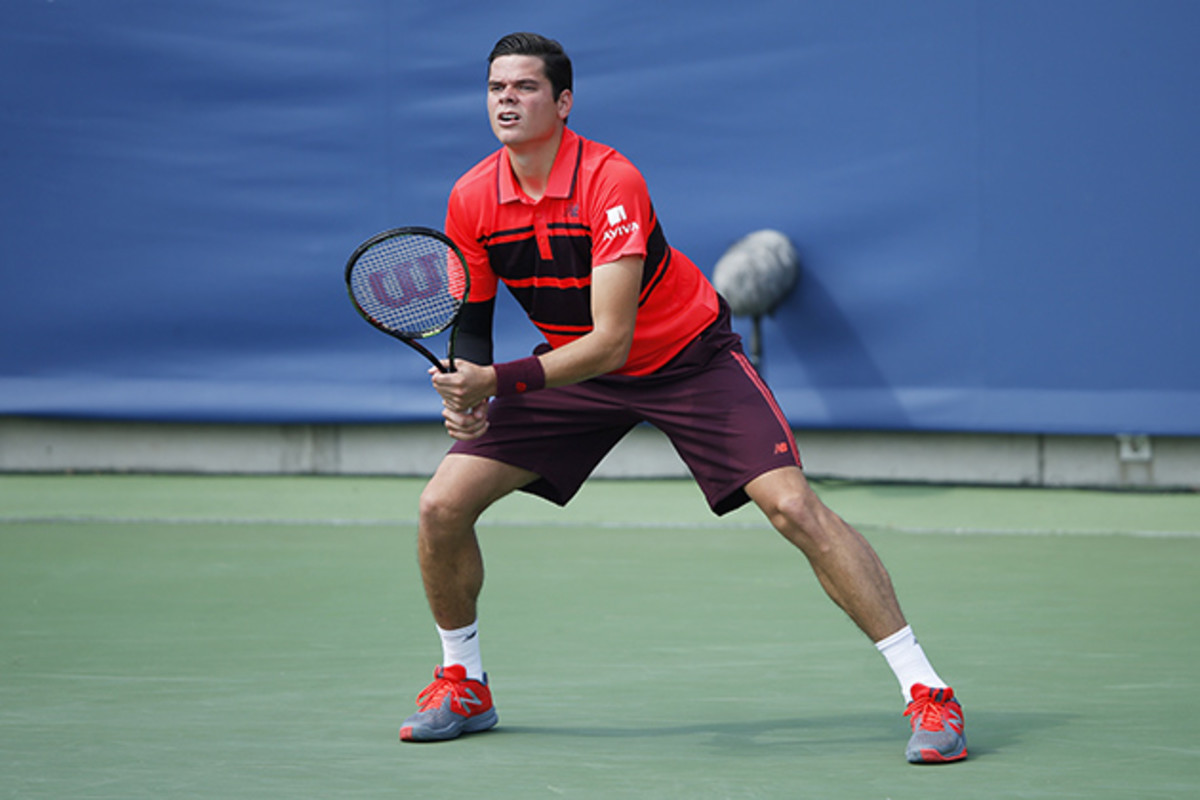Catching up with Milos Raonic ahead of the 2015 U.S. Open

Milos Raonic’s last three years at the U.S. Open have ended in similar fashion: In each tournament, the Canadian fell just short of the quarterfinals, losing in the fourth round to opponents that advanced at least to the semifinals.
Raonic enters this year’s U.S. Open after a disappointing summer. A foot injury kept him out of the French Open and he was knocked out in the third round at Wimbledon by Nick Kyrgios. In the lead-up to the U.S. Open, Raonic failed to win a match at Rogers Cup or the Western and Southern Open. Ahead of the final Slam of the season, the World No. 10 sat down with SI.com at a New Balance event to discuss New York City, his performance during the summer hardcourt season and why he feels more prepared than ever for this year’s U.S. Open.
Editor's note: This interview has been edited and condensed for clarity.
SI.com: What’s your favorite part about being in New York?
Raonic: Friends. Friends, and when family comes here. It’s a place I actually spend a lot of time in New York in my time off. I actually spend quite a bit of time here. And it’s fun having a lot of friends around when I’m playing. Because sometimes we can be in such far ends of the world, it’s a very familiar place to play so it’s a lot of fun.
40 insider tips for attending the 2015 U.S. Open in New York
SI.com: So when you’re not on the court in New York, what are you and your friends doing?
Raonic: Art galleries, good dinners, biking up and down either the East Side or the West Side. I think it always changes. I think that’s the best part about it.
SI.com: Are you an art aficionado?
Raonic: I’ve learned to really appreciate it, and my tastes and my interests have definitely grown. And I’ve tried to sort of participate in more things over the last two years, that’s for sure.
SI.com: What would you be doing if you weren’t a pro tennis player?
Raonic: Probably something in finance. That’s something I studied when I was in school, and I started up a degree in that. So I think that’s a very competitive place, and I definitely like competition.
SI.com: Here’s an off-base question: If you could play tennis against anyone—living or dead, tennis player or not a tennis player—who would it be?
Raonic: One person?
SI.com: If you need to name more than one, that’s fine.
Raonic: Muhammad Ali. And probably Steve Jobs is another person.
SI.com: So who would be the fourth if you wanted to play doubles?
Milos Raonic on his diet and how he's prepping for the U.S. Open
Raonic: [Michael] Jordan. Jordan for sure.
SI.com: Who would be your partner?
Raonic: Jordan. He’s probably the guy that could carry through the most sports. (Laughs)
SI.com: Do you have a favorite Grand Slam to play?
Raonic: Here, I would say. New York is just so familiar for me. I’ve had great night matches here, with friends being there. I grew up watching North American sport—basketball, hockey—so I like it when it’s a little bit more energetic, rowdier, heckling either for you or against you. I think it’s fun to have that in sport.
SI.com: The crowds at the U.S. Open are a little unique. They can get boisterous. Can that ever get distracting for you?
Raonic: No, I think it makes it more enjoyable. Especially last year, I think I played until almost three in the morning, and to have people there still that into it definitely made it that much more special of an experience.
SI.com: This year you didn’t have the best lead-up to the Open. Are you someone who believes in momentum from one tournament to the next, or do you look at each tournament kind of as a blank slate?

Raonic: Well, yeah I think it really does help obviously when you’re going into a tournament playing well. I think maybe you spend a little less time on the court trying to find your game and so forth, but it doesn’t in any way limit you from a result, because I feel like it’s really about getting better as the tournament progresses. So if you can sort of find your way through the first few matches by grinding, playing some hard tennis, putting a lot of effort in, you’re going to give yourself an opportunity to play better and better each match. So as long as you get that sort of rolling in your direction, everything can change very quickly throughout, especially a two-week span event.
SI.com: Your U.S. Open has ended the same way each of the last three years, losing in the fourth round in some really tough matches to some players who went on and did some great things in the tournament. What do you feel have been the primary barriers that have prevented you from reaching the quarters in this tournament?
Daily Data Viz: Serve speeds at the 2015 Grand Slam events
Raonic: I think it’s just been really matches that I’ve played I’ve just sort of lacked some experience. I thought last year’s match [Kei Nishikori defeated Raonic 4–6, 7–6, 6–7, 7–5, 6–4] that wasn’t the case, I thought Kei was playing great. But the year before [against Richard Gasquet], I think that was definitely a factor. Just not necessarily fully equipped to deal with that situation. And it’s not things somebody could tell you to expect, or these kinds of things. I think it’s things you have to go through and I think that’s the biggest thing that’s changed in my game. I’ve taken that experience, and I’ve taken those learning lessons and tried to make the most of them and tried to not repeat the same mistake twice and tried to really make progress every time.
SI.com: Your match last year against Nishikori was probably one of the best of the tournament. It didn’t turn out the best for you of course. How much have you thought about that match over the last year?
Raonic: I don’t think it stuck to me that much. I think I’ve had other more painful matches. I thought that was just a match where we were both playing great, and you leave it all out there and it goes one way or the other. That’s the way sport is. You ask everything of yourself, you put it in the match and you see where it goes. It sort of gives you more peace. I think it’s more other matches that have sometimes stung with me where I wish I would have played better or I wish I would have maybe figured things out sooner or things I missed during the match, those things bother me. That match, it was a great match and I put it all out there and it just turned out the way it did.
The short story: The details on Stan Wawrinka’s plaid shorts
SI.com: This year, your fourth round opponent could very well be Rafael Nadal. You beat him this year for the first time. If you two were to meet in the tournament like the U.S. Open, how much confidence would it give you going into that match knowing that you finally overcame him this year?
Raonic: I think there’s a lot more for me to go ahead of that. But I think it definitely gives you an understanding of what you need to do. Obviously it’s a very different circumstance, three out of five sets and it’s a very different match. We’re both in very different places since Indian Wells, but I think it’s too far really ahead to sort of think about. I think there’s so many challenges that I got to face before that, that I got to find the answers to.
SI.com: Do you look ahead at the draw when it comes out, or do you look at the first match?
Raonic: No, you’re telling me that I play Rafa in—what did you say? The fourth?
SI.com: Yeah, the fourth round if it goes that way.
Raonic: Yeah, that’s the first time of me knowing that. I just know who I have to prepare for I believe on Monday or whichever day I play.
SI.com: You mentioned a moment ago playing until 3 a.m. at the U.S. Open, that night atmosphere. What to you makes the night atmosphere at the U.S. Open so special?
Former pro James Blake to run 2015 New York City Marathon
Raonic: The crowd. Whether it be some things that are said maybe that aren’t, let’s say, typical in the tennis atmosphere or tennis world, but you see them all the time in basketball here or in all these other sports. You see it. That’s the really special part. When you feel a little bit tired, having all that energy—even if it’s against you or for you—in the stadium, it just makes that fatigue seem less relevant and so forth. It just keeps you pushing.
SI.com: One of the big storylines of this year’s tournament is Serena Williams, who of course has a chance to win her fifth straight major and the calendar Grand Slam. I know she’s on the women’s side, but is that something you’ve paid attention to, and what do you make of that achievement?
Raonic: Oh, I think it’s one of the greatest achievements, especially for women’s tennis, for her to do that. I don’t know where it puts her on the standings of Grand Slams all time. [Steffi Graf has 22 Grand Slams, most in the Open Era, while Williams enters the 2015 U.S. Open with 21.] But there’s a lot of things: She’d be the first woman to [win the calendar Grand Slam] since Steffi, and I think when you sort of look back at who you would say is the greatest female tennis player of all-time, you compare those two. So I think when you can maybe sort of distance yourself from that conversation, I think it’s really a chance for her to put a big exclamation mark on her legacy.
SI.com: As the U.S. Open gets started, what are you most looking forward to at this year’s tournament?
Raonic: Changing the story of my summer around. I think it’s a great opportunity, and there’s no better place to do it than New York.
